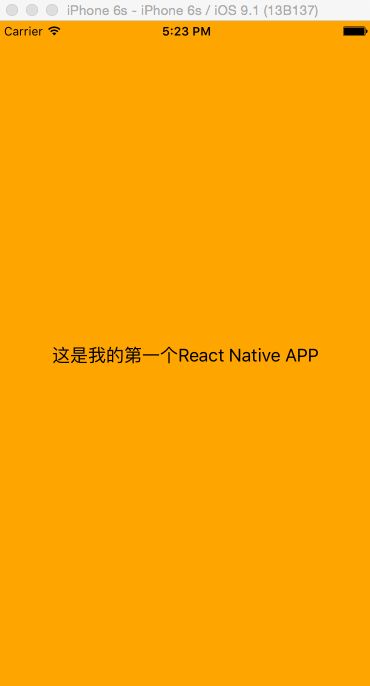React Native基础教程
React Native是Facebook开源的框架,用来写Android和iOS移动App。它的口号是 “Learning once, write anywhere”,目的是统一View的编写。我个人也是由于公司需要,故入坑学习,下面就我的理解简单总结下React Native的基本知识。
需要的预备知识:
1、学习JavaScript(最新JS核心标准ES6)
2、简单学习React.js(开发网页)
3、学习JSX(HTML和JavaScript的混写)
我主要讲一下几个方面:
1、React Native的基本模板写法
2、React Native的Flexbox布局
3、React Native组件化
4、React Native的生命周期
5、React Native的数据状态引用
1、React Native的基本模板写法
1 'use strict'; =====>(严格模式) 2 3 var React = require('react-native'); =====>(导入模块react-native,关键字是: require) 4 var { 5 AppRegistry, 6 StyleSheet, =====>(声明要用到得系统组件) 7 Text, 8 View, 9 } = React; 10 11 var FirstApp = React.createClass({ =====>(创建组件名称是:FirstApp, 关键字是createClass) 12 13 render: function() { =====>(渲染方法, 组件中必须得方法) 14 15 return ( 16 17 <View style={styles.container}> =====>(这几行就是JSX语法写的) 18 19 <Text style={{fontSize: 18}}>这是我的第一个React Native APP</Text> =====>(显示在手机屏幕上的内容在这写) 20 21 </View> =====>(这里用view包起来,而不是用div) 22 ); 23 } 24 }); 25 26 var styles = StyleSheet.create( =====>(创建样式,看上面加粗划线的代码,可以在这里定义,也可以直接写在代码里面,如上面的fontSize:18) 27 container: { 28 flex: 1, 29 justifyContent: 'center', 30 alignItems: 'center', 31 backgroundColor: 'orange' 32 } 33 }); 34 35 AppRegistry.registerComponent('FirstApp', () => FirstApp); =====>(注册应用,使能够加载运行, FirstApp就是你的App名称) 36 37 module.exports = FirstApp; =====>(导出组件,使能够在别的组件中用)
最终的打印结果:
2、React Native的Flexbox布局(样式)
官网的链接:http://facebook.github.io/react-native/docs/flexbox.html#content
这个比较简单,需自己多实践就行,简单说几个:
flex: 这个是一个灵活的布局属性,类似比例, 比如你想在一行中定义三张图片,它们的宽比为1:3:2,那么你可以分别设置它们的flex为: 1,3,2
flexDirection: 这个是设置布局的方向(column 和 row), 视图排列方法是列布局还是行布局
justifyContent 和 alignItems: 这2个是水平和垂直布局,可以设置水平居中,垂直居中等
margin(包括marginLeft, marginRight, marginTop, marginBottom) :这个是设置间距(距离左,右, 上, 下)多少
position (包括absolute和relative): 这个是设置视图的位置是固定的还是相对的
......
3、React Native的组件化, 我们可以分功能来自定义模块写代码,然后把所有模块组合起来,就是一个完整的程序了
1 'use strict'; 2 3 var React = require('react-native'); 4 var { 5 AppRegistry, 6 StyleSheet, 7 Text, 8 View, 9 } = React; 10 11 var FirstApp = React.createClass({ 12 13 render: function() { 14 15 return ( 16 17 <View style={styles.container}> 18 19 <HelloWorld myText='我是第一' /> 20 <HelloWorld myText='我是第二' /> =====>(这里三个是引用了下面定义的组件,HelloWorld自动成为FirstApp的子组件) 21 <HelloWorld myText='我是第三' /> =====>(myText是传给HelloWorld的属性) 22 23 </View> 24 ); 25 } 26 }); 27 28 var HelloWorld = React.createClass({ 29 30 render: function() { 31 32 return ( 33 34 <View> 35 <Text style={{fontSize: 20, color: 'red'}}>{this.props.myText}</Text> 36 </View> =====>(从父组件传过来的myText属性,用this.props.myText接收) 37 ); 38 } 39 });
最终的打印结果:
4、React Native的生命周期
a、getInitialState: 在组建被挂载之前调用,我们一般在里面定义初始state值
b、getDefaultProps: 在组件类创建的时候调用一次,然后返回值被缓存下来。如果父组件没有指定 getDefaultProps 中定义的属性,则此处返回的对象中的相应属性将会合并到 this.props
c、componentWillMount: 服务器端和客户端都只调用一次,在初始化渲染执行之前立刻调用
d、render: 执行视图的渲染操作
e、componentDidMount: 在初始化渲染执行之后立刻调用一次,仅客户端有效(服务器端不会调用)
f、componentWillUnmount: 组件从DOM中移除时调用,一般在次方法进行必要的清理工作
1 'use strict'; 2 3 var React = require('react-native'); 4 var { 5 AppRegistry, 6 StyleSheet, 7 Text, 8 View, 9 } = React; 10 11 var FirstApp = React.createClass({ 12 13 getDefaultProps: function() { 14 15 console.log('getDefaultProps'); 16 17 }, 18 19 getInitialState: function() { 20 21 console.log('getInitialState'); 22 23 return { 24 25 }; 26 }, 27 28 componentWillMount: function() { 29 30 console.log('componentWillMount'); 31 }, 32 33 componentDidMount: function() { 34 35 console.log('componentDidMount'); 36 }, 37 38 componentWillUnmount: function() { 39 40 console.log('componentWillUnmount'); 41 }, 42 43 render: function() { 44 45 console.log('render'); 46 47 return ( 48 49 <View style={styles.container}> 50 51 <HelloWorld myText='我是第一' /> 52 <HelloWorld myText='我是第二' /> 53 <HelloWorld myText='我是第三' /> 54 55 </View> 56 ); 57 } 58 }); 59 60 var HelloWorld = React.createClass({ 61 62 render: function() { 63 64 return ( 65 66 <View> 67 <Text style={{fontSize: 20, color: 'red'}}>{this.props.myText}</Text> 68 </View> 69 ); 70 } 71 }); 72 73 var styles = StyleSheet.create({ 74 container: { 75 flex: 1, 76 justifyContent: 'center', 77 alignItems: 'center', 78 backgroundColor: 'orange' 79 } 80 }); 81 82 AppRegistry.registerComponent('FirstApp', () => FirstApp); 83 84 module.exports = FirstApp;
最终的打印结果(执行顺序):
5、React Native的数据状态引用
a、props: 属性, 用于不同组件之间数值传递,一般是从父组件中传值给子组件,子组件最好不要修改此值,而由父组件来修改,进而更新子组件的值
还是上面的栗子:
1 'use strict'; 2 3 var React = require('react-native'); 4 var { 5 AppRegistry, 6 StyleSheet, 7 Text, 8 View, 9 } = React; 10 11 var FirstApp = React.createClass({ 12 13 render: function() { 14 15 console.log('render'); 16 17 return ( 18 19 <View style={styles.container}> 20 21 <HelloWorld myText='我是第一' /> 22 <HelloWorld myText='我是第二' /> =====>(HelloWorld嵌套在FirstApp中,所以HelloWorld自动成为了FirstApp的子组 件,myText就是要传递给子组件的属性值) 23 <HelloWorld myText='我是第三' /> 24 25 </View> 26 ); 27 } 28 }); 29 30 var HelloWorld = React.createClass({ 31 32 render: function() { 33 34 return ( 35 36 <View> 37 <Text style={{fontSize: 20, color: 'red'}}>{this.props.myText}</Text> =====>(HelloWorld通过props来接收传 过来的myText属性值) 38 </View> 39 ); 40 } 41 }); 42 43 var styles = StyleSheet.create({ 44 container: { 45 flex: 1, 46 justifyContent: 'center', 47 alignItems: 'center', 48 backgroundColor: 'orange' 49 } 50 }); 51 52 AppRegistry.registerComponent('FirstApp', () => FirstApp); 53 54 module.exports = FirstApp;
最终的打印结果:
b、state: 状态,用于同一组件中数据的更新
1 'use strict'; 2 3 var React = require('react-native'); 4 var { 5 AppRegistry, 6 StyleSheet, 7 Text, 8 View, 9 TouchableHighlight 10 } = React; 11 12 var FirstApp = React.createClass({ 13 14 getInitialState: function() { 15 16 return { 17 myValue: '我是初始值' =====>(设置初始值) 18 }; 19 20 }, 21 22 render: function() { 23 24 console.log('render'); 25 26 return ( 27 28 <View style={{flex: 1, justifyContent: 'center', alignItems: 'center'}}> 29 <Text onPress={this.changeText} =====>(设置文字点击事件,当点击的时候会调用changeText方法) 30 style={{fontSize: 30, 31 color: 'orange', =====>(设置文字样式) 32 textAlign: 'center'}}> 33 34 {this.state.myValue} =====>(第一次加载数据的时候会获取初始值,用state来获取到初始值) 35 </Text> 36 </View> 37 ); 38 }, 39 40 changeText: function() { 41 42 this.setState({ =====>(这是文字的点击事件, 当我想要更改state初始值的时候,需要用到setState来更改) 43 44 myValue: '我是修改后的值' =====>(修改初始值myValue,当我修改这里后,系统会自动去调用render函数方法,this.state.myValue会自动更新成最新的值,即:我是修改后的值) 45 }) 46 } 47 }); 48 49 50 AppRegistry.registerComponent('FirstApp', () => FirstApp); 51 52 module.exports = FirstApp;
最终的打印结果:
c、ref: 用来指示render中某组件,调用的话就是this.refs.xxx.xxx
1 'use strict'; 2 3 var React = require('react-native'); 4 var { 5 AppRegistry, 6 StyleSheet, 7 Text, 8 View, 9 Image, 10 TouchableHighlight 11 } = React; 12 13 var FirstApp = React.createClass({ 14 15 render: function() { 16 17 console.log('render'); 18 19 return ( 20 21 <View style={{flex: 1, justifyContent: 'center', alignItems: 'center', backgroundColor: 'yellow'}}> 22 23 <Image 24 ref='myImg' 25 source={{uri: 'http://pic14.nipic.com/20110522/7411759_164157418126_2.jpg' }} 26 style={{width: 350, height: 350}} /> =====>(设置一张图片,并且设置宽高为350) 27 28 <Text onPress={this.changePic} style={{marginTop: 50}}>改变图片的大小</Text> ===>(点击文字,触发事件changePic) 29 </View> 30 ); 31 }, 32 33 changePic: function() { =====>(点击文字会调用这个方法) 34 35 console.log('我打印出上面的image的属性来看看:',this.refs.myImg.props); =====>(打印出上面的Image来看看) 36 } 37 }); 38 39 AppRegistry.registerComponent('FirstApp', () => FirstApp); 40 41 module.exports = FirstApp;
最终的执行结果:





